Mechanical and Magnetic Investigations of Balls Made of AISI 1010 and AISI 1085 Steels after Nitriding and Annealing
Abstract
1. Introduction
2. Materials and Methods
2.1. Materials and Parameters of Nitriding and Annealing
2.2. Metallographic Research
2.3. Magnetic Resonance Experiment
3. Results
3.1. Phase Transformations of Iron Nitrides
3.2. FMR Spectra
3.3. Magnetic Susceptibility Measurements
4. Conclusions
Author Contributions
Funding
Data Availability Statement
Conflicts of Interest
References
- Borgioli, F. The Corrosion Behavior in Different Environments of Austenitic Stainless Steels Subjected to Thermochemical Surface Treatments at Low Temperatures: An Overview. Metals 2023, 13, 776. [Google Scholar] [CrossRef]
- Godec, M.; Ruiz-Zepeda, F.; Podgoenik, B.; Donik, C.; Kocijan, A.; Balantic, D.A.S. The influence of the plasma-nitriding temperature on the microstructure evolution and surface properties of additive-manufactured 18Ni300 maraging steel. Surf. Coat. Technol. 2022, 4333, 12808. [Google Scholar] [CrossRef]
- Sah, J.V.; Dwivedi, P.K.; Mukherjee, S.; Jhala, G.; Joseph, A. Influence of γN’ and ɛN’ phases on the properties of AISI 304L after low-temperature plasma nitrocarburizing. J. Vac. Sci. Technol. A 2023, 41, 33101. [Google Scholar] [CrossRef]
- Hono, K.; Sepehri-Amin, H. Strategy for high-coercivity Nd–Fe–B magnet. Scr. Mater. 2012, 67, 530–535. [Google Scholar] [CrossRef]
- Gupta, P.; Fiedler, H.; Rubanov, S.; Kennedy, J. Magnetisation and magnetic anisotropy of ion beam synthesized iron nitride. J. Magn. Magn. Mat. 2021, 517, 167388. [Google Scholar] [CrossRef]
- Zhai, Y.; Zhu, D.; Duan, S.; Luo, F. Novel Fe3-4N@FCI particles with improved microwave absorption and antioxidation properties prepared by surface nitridation method. Chem. Phys. Lett. 2020, 755, 137803. [Google Scholar] [CrossRef]
- Wojciechowski, P.; Lewandowski, M. Iron Nitride Thin Films: Growth, Structure, and Properties. Cryst. Growth Des. 2022, 22, 4618–4639. [Google Scholar] [CrossRef]
- Yamaguchi, T.; Sakita, M.; Nakamura, M.; Kobira, T. Synthesis and Characteristics of Fe4N Powders and Thin Films. J. Magn. Magn. Mater. 2000, 215–216, 529–531. [Google Scholar] [CrossRef]
- Liu, J.; Guo, G.; Zhang, F.; Wu, Y.; Ma, B.; Wang, J.-P. Synthesis of α″-Fe16N2 Ribbons with a Porous Structure. Nanoscale Adv. 2019, 1, 1337–1342. [Google Scholar] [CrossRef]
- Wang, X.; Zheng, W.T.; Tian, H.W.; Yu, S.S.; Xu, W.; Meng, S.H.; He, X.D.; Han, J.C.; Sun, C.Q.; Tay, B.K. Growth, Structural, and Magnetic Properties of Iron Nitride Thin Films Deposited by DC Magnetron Sputtering. Appl. Surf. Sci. 2003, 220, 30–39. [Google Scholar] [CrossRef]
- Zheng, Q.; Yu, M.; Wen, W.; Liu, S.; Liang, X.; Wang, C.; Dai, Y.Y.; Xu, Y. Porous and flake-like γ′ -Fe4N@iron oxides with enhanced microwave absorption performance. Ceram. Internat. 2021, 47, 8315–8321. [Google Scholar] [CrossRef]
- Jiang, H.; Tao, K.; Li, H. The thermostability of the Fe16N2 phase deposited on a GaAs substrate by ion-beam-assisted deposition. J. Phys. Condens. Matter 1994, 6, L279. [Google Scholar] [CrossRef]
- Yurovskikh, A.S.; Kardonina, N.I.; Kolpakov, A.S. Phase transformations in nitrided iron powders. Met. Sci. Heat Treat. 2015, 57, 507–514. [Google Scholar] [CrossRef]
- Frączek, T.; Michalski, J.; Kucharska, B.; Opydo, M.; Ogorek, M. Phase transformations in the nitrided layer during annealing under reduced pressure. Arch. Civ. Mech. Eng. 2021, 21, 48. [Google Scholar] [CrossRef]
- Liapina, T.; Leineweber, A.; Mittemeijer, E.J.; Kockelmann, W. The lattice parameters of ɛ-iron nitrides: Lattice strains due to a varying degree of nitrogen ordering. Acta Mater. 2004, 52, 173–180. [Google Scholar] [CrossRef]
- Gupta, M.; Tayal, A.; Gupta, A.; Gupta, R.; Stahn, J.; Horisberger, M.; Wildes, A. Iron and Nitrogen Self-diffusion in Non-Magnetic Iron Nitrides. J. Appl. Phys. 2011, 110, 123518. [Google Scholar] [CrossRef]
- Lei, X.; Wang, J.; Peng, R.; Wang, W. The controllable magnetic properties of Fe3N nanoparticles synthesized by a simple urea route. Mat. Res. Bull. 2020, 122, 110662. [Google Scholar] [CrossRef]
- Robbins, M.; White, J.G. Magnetic properties of epsilon-iron nitride. J. Phys. Chem. Solids 1964, 25, 717–720. [Google Scholar] [CrossRef]
- Kucharska, B.; Michalski, J.; Wójcik, G. Mechanical and microstructural aspects of C20-steel blades subjected to gas nitriding. Arch. Civ. Mech. Eng. 2019, 19, 147–156. [Google Scholar] [CrossRef]
- Michalski, J.; Tacikowski, J.; Wach, P.; Lunarska, E.; Baum, H. Formation of single-phase layer of γ’-nitride in controlled gas nitriding. Met. Sci. Heat Treat. 2005, 47, 516–519. [Google Scholar] [CrossRef]
- Arabczyk, W.; Pelka, R.; Kocemba, I.; Brzoza-Kos, A.; Wyszkowski, A.; Lendzion-Bieluń, Z. Study of Phase Transformation Processes Occurring in the Nanocrystalline Iron/Ammonia/Hydrogen System by the Magnetic Permeability Measurement Method. J. Phys. Chem. C 2022, 126, 7704–7710. [Google Scholar] [CrossRef]
- Małdziński, L. Termodynamiczne i Technologiczne Aspekty Wytwarzania Warstwy Azotowanej na Żelazie i Stalach w Procesach Azotowania Gazowego (Thermodynamic and Technological Aspects of the Production of a Nitrided Layer on Iron and Steels in Gas Nitriding Processes); Wydawnictwo Politechniki Poznańskiej: Poznań, Poland, 2002. (In Polish) [Google Scholar]
- Holst, A.; Kante, S.; Leineweber, A.; Buchwalder, A. Mechanism of Layer Formation during Gas Nitriding of Remelted Ledeburitic Surface Layers on Unalloyed Cast Irons. Metals 2023, 13, 156. [Google Scholar] [CrossRef]
- Dyson, F.J. Electron spin resonance absorption in metals. II. Theory of electron diffusion and the skin effect. Phys. Rev. 1955, 98, 349. [Google Scholar] [CrossRef]
- Bojanowski, B.; Kaczmarek, S.M. Electron spin resonance of FeVO4. Mater. Sci. Pol. 2014, 32, 188–192. [Google Scholar] [CrossRef]
- Kaczmarek, S.M.; Fuks, H.; Berkowski, M.; Głowacki, M.; Bojanowski, B. EPR properties of concentrated NdVO4 single crystal system. Appl. Magn. Res. 2015, 46, 1023–1033. [Google Scholar] [CrossRef]
- Kaczmarek, S.M.; Michalski, J.; Leniec, G.; Fuks, H.; Frączek, T.; Dudek, A. Applying the FMR technique to analyzing the influence of nitriding on the magnetic properties of steel. Materials 2022, 15, 4080. [Google Scholar] [CrossRef] [PubMed]
- Crangle, J.; Fogarty, A.; Taylor, M.J. Weak ferromagnetism in ‘non-magnetic’ austenitic stainless steel. J. Magn. Magn. Mater. 1992, 111, 255–259. [Google Scholar] [CrossRef]
- Jian, Z.; Kumar, N.P.; Zhong, M.; Yemin, H.; Reddy, P.V. Structural, Magnetic and Dielectric Properties of Bi0.9Re0.1FeO3 (Re = La, Sm, Gd and Y). J. Supercond. Nov. Magn. 2015, 28, 2627–2635. [Google Scholar] [CrossRef]
- Borgioli, F.; Galvanetto, E.; Bacci, T. Low temperature nitriding of AISI 300 and 200 series austenitic stainless steels. Vacuum 2016, 127, 51–60. [Google Scholar] [CrossRef]

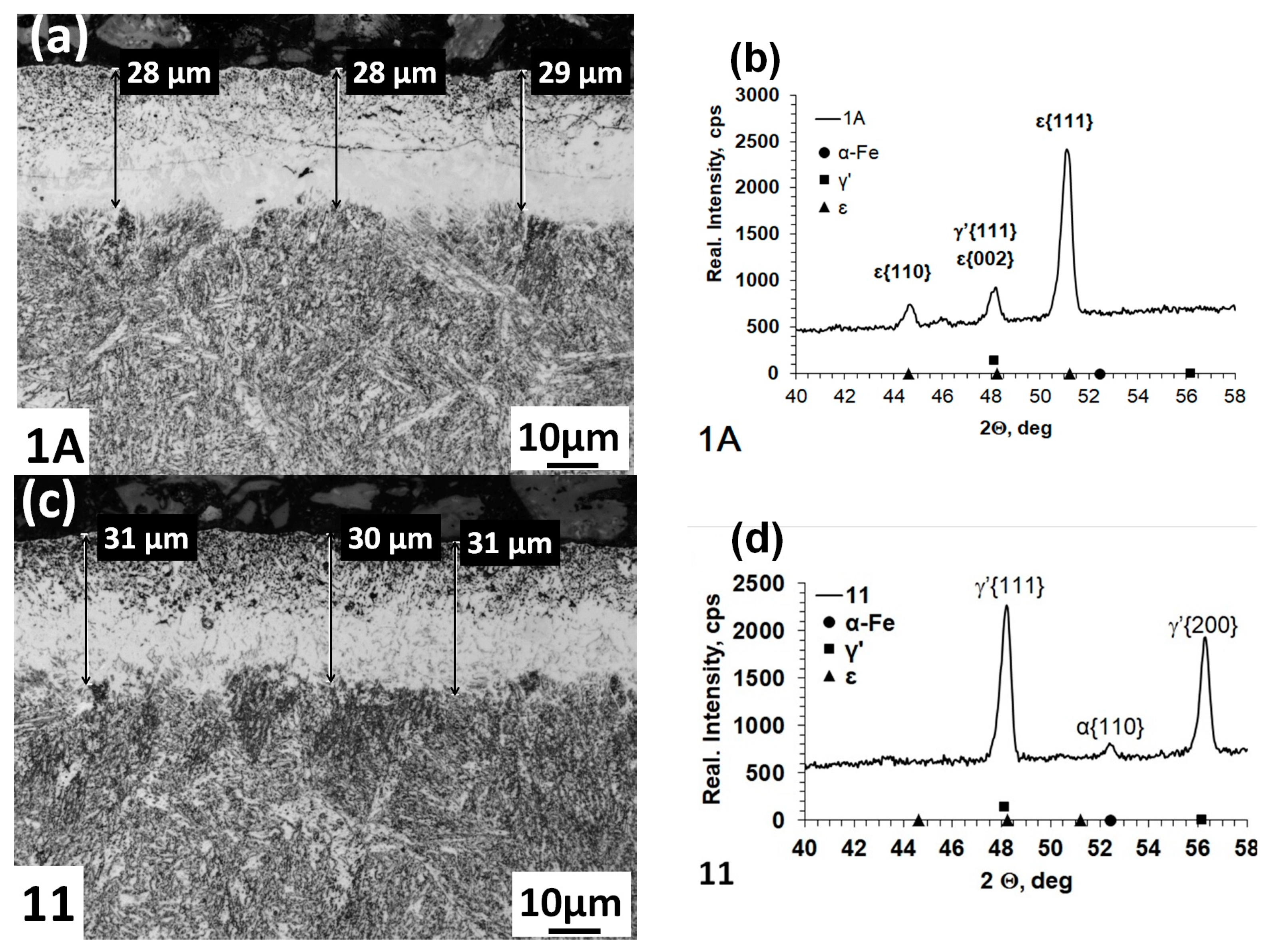

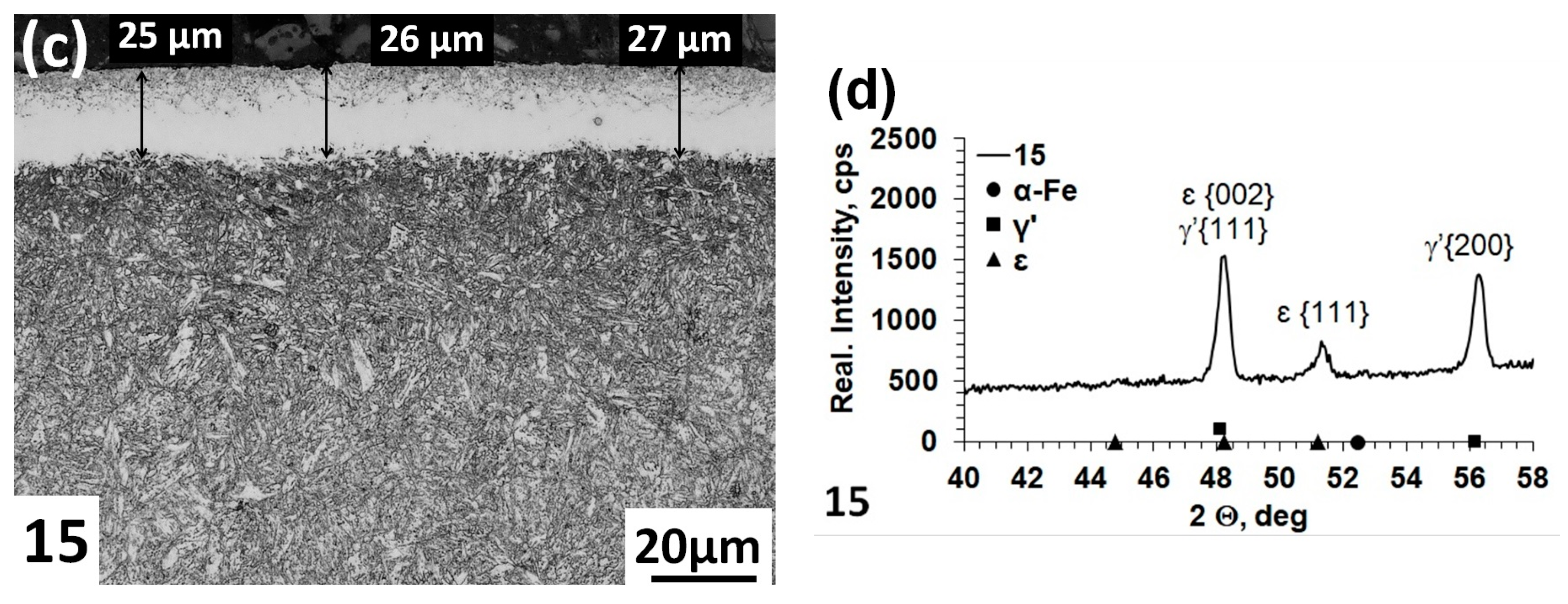

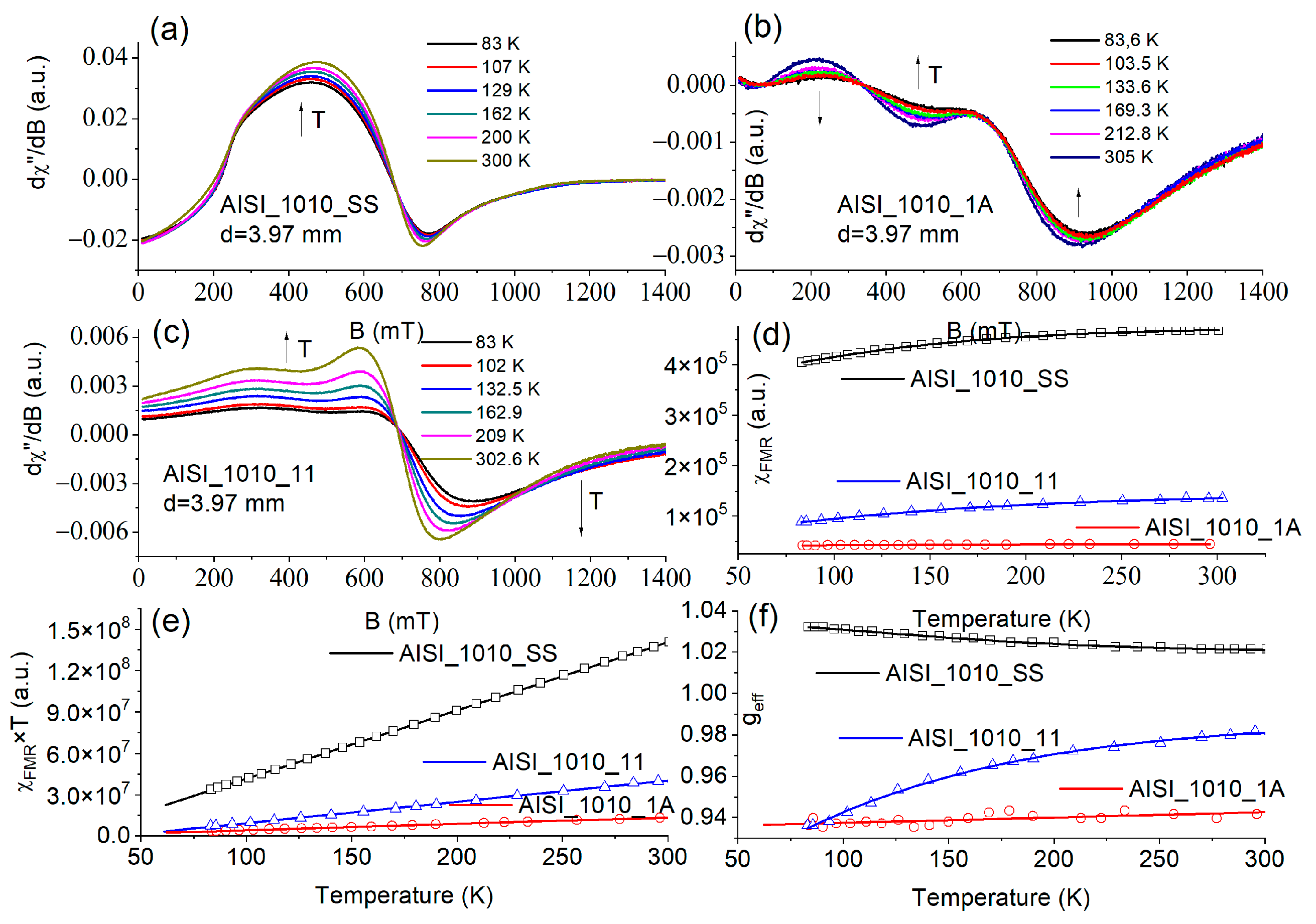
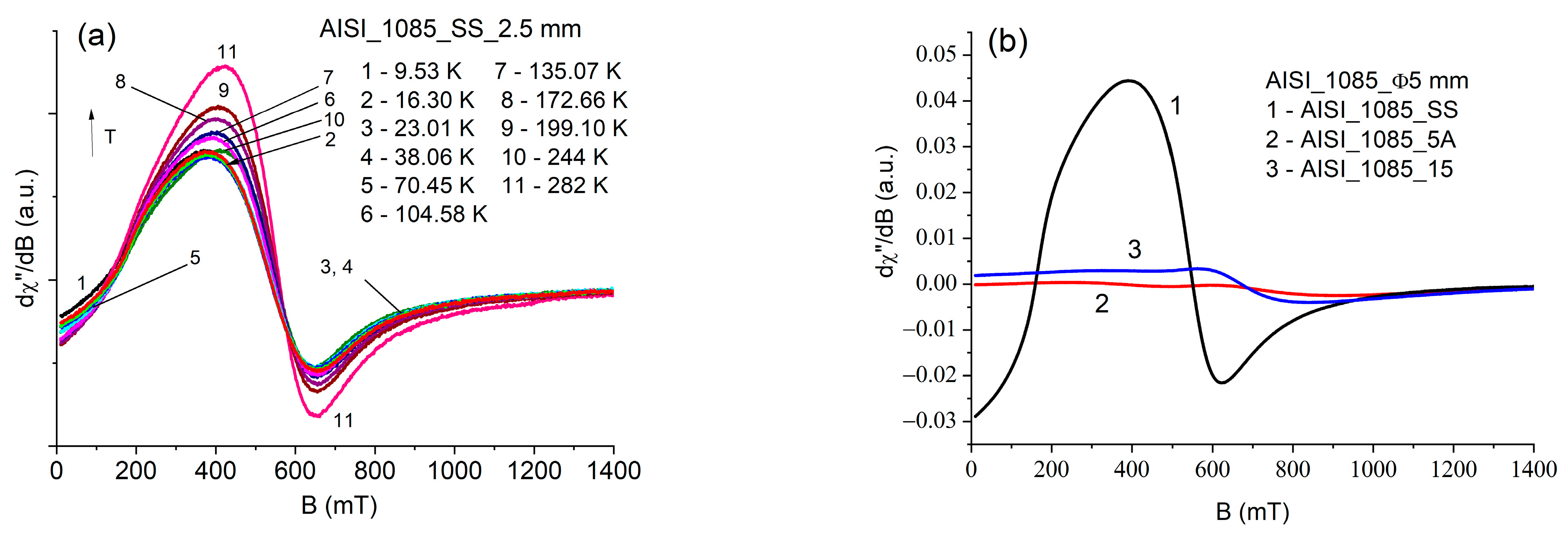

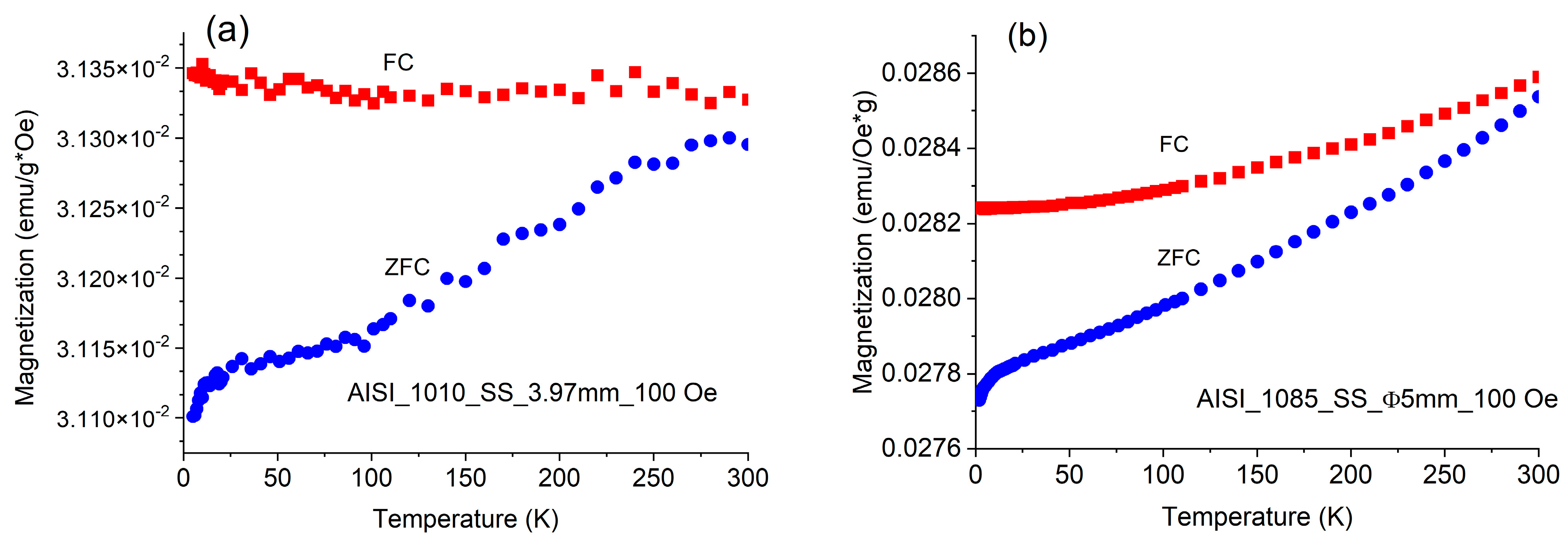
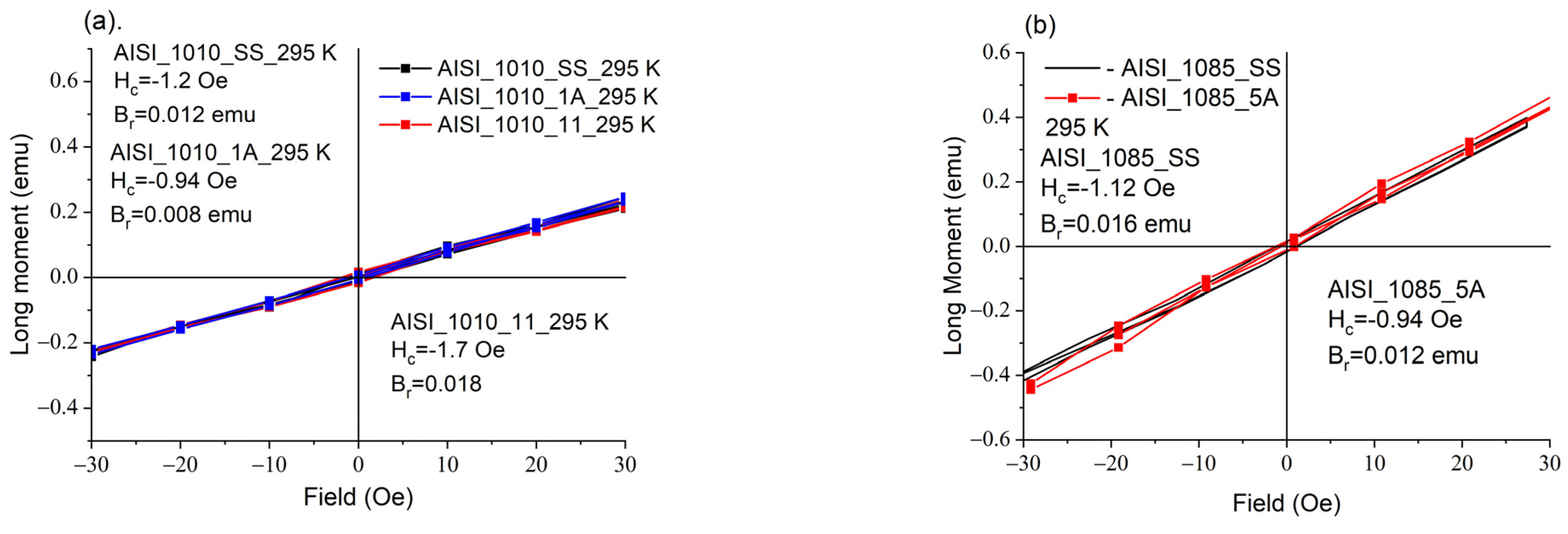
| Grade Steel | Sample No. | DK (mm) | Element Contents in wt.% | ||||
|---|---|---|---|---|---|---|---|
| C | Mn | Si | P | S | |||
| AISI 1010 | 1A; 11 | 3.97 | 0.10 | 0.5 | 0.1 | 0.04 | 0.05 |
| AISI 1085 | 5A; 15 | 5.0 | 0.85 | 0.9 | 0.3 | 0.04 | 0.05 |
| Sample No. | Parameters of Nitriding | Parameters of Annealing | |||||
|---|---|---|---|---|---|---|---|
| T (°C) | t (h) | Np (atm−05) | Inlet Atmosphere | T (°C) | t (h) | Inlet Atmosphere | |
| 1A; 5A | 570 | 5 | 2.5 | NH3 | - | - | - |
| 11; 15 | 570 | 5 | 2.5 | - | 520 | 4 | N2/Ar/P = 150 Pa |
| Grade Steel | Sample No. | DK (mm) | gmp (µm) | gpor (µm) |
|---|---|---|---|---|
| AISI 1010 | 1A | 3969 | 29 ± 1 | 10 ± 1 |
| AISI 1010 | 11 | 3969 | 30 ± 1 | 12 ± 1 |
| AISI 1085 | 5A | 5.0 | 25 ± 1 | 10 ± 1 |
| AISI 1085 | 15 | 5.0 | 25 ± 1 | 10 ± 1 |
| Grade Steel | Sample No. | PC WL | LP Fe4N (Å) | LP Fe2–3N (Å) | PC WL (%) | ||
|---|---|---|---|---|---|---|---|
| a = b = c | a = b | c | Fe4N | Fe2–3N | |||
| AISI 1010 | 1A | Fe4N-γ′; Fe2–3N-ɛ | 3.7986 | 4.6932 | 4.3783 | 4 ± 2 | 95 ± 2 |
| AISI 1010 | 11 | Fe4N-γ′ | 3.8007 | - | - | 97 ± 2 | - |
| AISI 1085 | 5A | Fe4N-γ′; Fe2–3N-ɛ | 3.7978 | 4.6842 | 4.3750 | 13 ± 2 | 87 ± 2 |
| AISI 1085 | 15 | Fe4N-γ′; Fe2–3N-ɛ | 3.7963 | 4.6998 | 4.3817 | 39 ± 2 | 61 ± 2 |
Disclaimer/Publisher’s Note: The statements, opinions and data contained in all publications are solely those of the individual author(s) and contributor(s) and not of MDPI and/or the editor(s). MDPI and/or the editor(s) disclaim responsibility for any injury to people or property resulting from any ideas, methods, instructions or products referred to in the content. |
© 2023 by the authors. Licensee MDPI, Basel, Switzerland. This article is an open access article distributed under the terms and conditions of the Creative Commons Attribution (CC BY) license (https://creativecommons.org/licenses/by/4.0/).
Share and Cite
Kaczmarek, S.M.; Michalski, J.; Frączek, T.; Dudek, A.; Fuks, H.; Leniec, G. Mechanical and Magnetic Investigations of Balls Made of AISI 1010 and AISI 1085 Steels after Nitriding and Annealing. Metals 2023, 13, 1060. https://doi.org/10.3390/met13061060
Kaczmarek SM, Michalski J, Frączek T, Dudek A, Fuks H, Leniec G. Mechanical and Magnetic Investigations of Balls Made of AISI 1010 and AISI 1085 Steels after Nitriding and Annealing. Metals. 2023; 13(6):1060. https://doi.org/10.3390/met13061060
Chicago/Turabian StyleKaczmarek, Sławomir Maksymilian, Jerzy Michalski, Tadeusz Frączek, Agata Dudek, Hubert Fuks, and Grzegorz Leniec. 2023. "Mechanical and Magnetic Investigations of Balls Made of AISI 1010 and AISI 1085 Steels after Nitriding and Annealing" Metals 13, no. 6: 1060. https://doi.org/10.3390/met13061060
APA StyleKaczmarek, S. M., Michalski, J., Frączek, T., Dudek, A., Fuks, H., & Leniec, G. (2023). Mechanical and Magnetic Investigations of Balls Made of AISI 1010 and AISI 1085 Steels after Nitriding and Annealing. Metals, 13(6), 1060. https://doi.org/10.3390/met13061060







